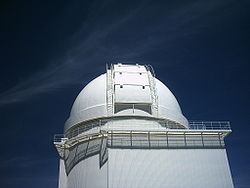 Enclosure of the 2.2-meter telescope at Calar Alto Observatory | |||||||||||
| Alternative names | Spanish Astronomical Centre in Andalusia | ||||||||||
|---|---|---|---|---|---|---|---|---|---|---|---|
| Organization | Institute of Astrophysics of Andalusia (IAA-CSIC) Council of Andalusia | ||||||||||
| Observatory code | 493 | ||||||||||
| Location | Almería, Spain | ||||||||||
| Coordinates | 37°13′25″N 2°32′46″W / 37.22361°N 2.54611°W | ||||||||||
| Altitude | 2,168 m (7,113 ft) | ||||||||||
| Website | www | ||||||||||
| Telescopes | |||||||||||
| |||||||||||
| | |||||||||||
| see § List of discovered minor planets |
The Calar Alto Observatory (Centro Astronómico Hispano en Andalucía or "Spanish Astronomical Centre in Andalusia") is an astronomical observatory located in Almería province in Spain on Calar Alto, a 2,168-meter-high (7,113 ft) mountain in the Sierra de Los Filabres subrange of the Sierra Nevada.[2]
Until 2018, Calar Alto was owned and operated jointly by the German Max Planck Institute for Astronomy in Heidelberg, and the Spanish Institute of Astrophysics of Andalusia (IAA-CSIC) in Granada. It was named the "German–Spanish Astronomical Centre" (in Spanish, Centro Astronómico Hispano-Alemán (CAHA); in German, Deutsch-Spanisches Astronomisches Zentrum). In 2019, the Council of Andalusia takes over the German partner, sharing the observatory with the Spanish National Research Council through its head institute, IAA-CSIC.
Calar Alto telescopes are used for a broad range of observations, from objects in the Solar System[2] to cosmology (the Alhambra and CALIFA surveys), including the search for exoplanets (the CARMENES survey).
The 3.5-meter telescope is the largest telescope in mainland Europe, though there are three larger telescopes on the Spanish island of La Palma at the Roque de los Muchachos Observatory. The minor planet 189202 Calar Alto, discovered by Felix Hormuth at Starkenburg Observatory in 2003, was named in honor of the observatory site.[2]
